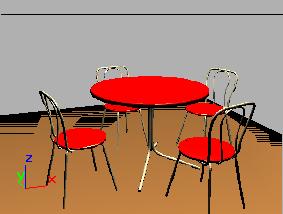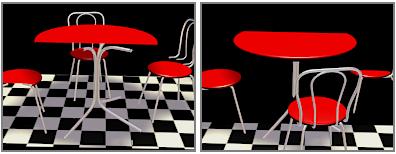Common Camera Parameters
Create panel > Cameras > Target button or Free button > Parameters rollout
Most of the camera controls are common to both kinds of cameras. This topic describes those controls.
Procedures
To view a wider area, do either of the following:
-
Use the FOV spinner to increase the camera's field of view.
-
Click a button with a shorter focal length. Use the Lens spinner to give the focal length a value other than the preset "stock" values on the buttons.
To view a narrower area, do either of the following:
-
Change the FOV parameter to decrease the camera's field of view.
-
Click a button with a longer focal length. Use the Lens parameter to give the focal length a value other than the preset "stock" values on the buttons.
In a camera viewport, the FOV button lets you adjust the field of view interactively.
The camera viewport Perspective button also changes the FOV in conjunction with dollying the camera.
Note: Only the FOV value is saved with the camera. The focal length value is merely an alternative way to express and select the FOV.
To set the camera lens size, do one of the following:
-
In the Stock Lenses group, click a button to choose a stock focal length.
-
Set the Lens spinner to a custom focal length.
Tip: If you want to maintain the same lens, avoid using the FOV or Perspective controls among the navigation icon buttons, and don't change the FOV spinner.
To display a camera's cone:
-
Turn on Show Cone.
The camera's field-of-view cone appears outlined in light blue.
Note: A camera's cone is always visible while the camera object is selected, regardless of the Show Cone setting.
To display a camera's horizon line:
-
Turn on Show Horizon.
A dark gray line appears at the level of the horizon in the camera's viewport.

Horizon line shown near the top of the scene
The horizon line might not be visible if the horizon is beyond the camera's field of view, or if the camera is tilted very high or low.
To set clipping planes:
-
Turn on Clip Manually.
When Clip Manually is off, the camera ignores the location of the Near and Far clipping planes, and their controls are grayed out. The cameraÆs viewport shows all geometry within the cameraÆs field of view.
-
Set the Near Clip value to position the near clipping plane.
Objects closer to the camera than the Near distance are not visible to the camera and donÆt appear in the cameraÆs viewport.
-
Set the Far Clip value to position the far clipping plane.
Objects farther from the camera than the Far distance are not visible to the camera and donÆt appear in the cameraÆs viewport.
You can set the Near clipping plane close to the camera so that it doesn't exclude any geometry, and still use the Far plane to exclude objects. Similarly, you can set the Far clipping plane far enough from the camera that it doesn't exclude any geometry, and still use the Near plane to exclude objects.
The Near value is constrained to be less than the Far value.
If the clipping plane intersects an object, it cuts through that object, creating a cutaway view.

The effect of clipping planes
Interface

Lens: Sets the camera's focal length in millimeters. Use the Lens spinner to give the focal length a value other than the preset "stock" values on the buttons in the Stock Lenses group box.
FOV Direction flyout: Lets you choose how to apply the field of view (FOV) value:
 Horizontal: (The default.) Applies the FOV horizontally. This is the standard way to set and measure the FOV.
Horizontal: (The default.) Applies the FOV horizontally. This is the standard way to set and measure the FOV.
 Vertical: Applies the FOV vertically.
Vertical: Applies the FOV vertically.
 Diagonal: Applies the FOV diagonally, from one corner of the viewport to the other.
Diagonal: Applies the FOV diagonally, from one corner of the viewport to the other.
FOV: Determines how wide an area the camera views (field of view). When FOV Direction is horizontal (the default), the FOV parameter directly sets the arc of the camera's horizon, measured in degrees. You can also set the FOV Direction to measure FOV vertically or diagonally.
You can also adjust the field of view interactively in a camera viewport by using the FOV button.
Orthographic Projection: When on, the camera view looks just like a User view. When off, the camera view is the standard perspective-like view. While Orthographic Projection is in effect, the viewport navigation buttons behave as they ordinarily do, except for Perspective. Perspective function still moves the camera and changes the FOV, but the Orthographic Projection cancels the two out, so you don't see any change until you turn off Orthographic Projection.
Stock Lenses group
15mm, 20mm, 24mm, 28mm, 35mm, 50mm, 85mm, 135mm, 200mm: These preset values set the camera's focal length in millimeters.
Type: Changes the camera's type from a Target Camera to a Free Camera, and vice versa.
Note: When you switch from a target camera to a free camera, any animation applied to the camera's target is lost, because the target object goes away.
Show Cone: Displays the cone (actually a pyramid) defined by a camera's field of view. The cone appears in the other viewports but does not appear in a camera viewport.
Show Horizon: Displays the horizon line. A dark gray line appears at the level of the horizon in the camera's viewport.
Environment Ranges group
Near Range and Far Range: Determine the near and far range limits for atmospheric effects. Objects between the two limits fade between the Far % and Near % values.
Show: Displays rectangles within the camera's cone to show the Near and Far range settings.
Clipping Planes group
Sets options to define clipping planes. In viewports, clipping planes are displayed as red rectangles (with diagonals) within the camera's cone.
Clip Manually: Turn on to define clipping planes.
When Clip Manually is off, geometry closer to the camera than 3 units is not displayed. To override this, use Clip Manually.
Near Clip and Far Clip: Sets near and far planes. Objects closer than the near clipping plane or farther than the far clipping plane are invisible to the camera. The limit of the Far Clip value is 10 to the power of 32.
With manual clipping on, the near clipping plane can be as close to the camera as 0.1 unit.
Caution: Extremely large Far Clip values can produce floating-point error, which can cause Z-buffer problems in the viewport, such as objects appearing in front of other objects when they shouldn't.
Target Distance: With a free camera, sets a point to use as an invisible target so that you can orbit a camera around that point. With a target camera, indicates the distance between the camera and its target.



 Horizontal: (The default.) Applies the FOV horizontally. This is the standard way to set and measure the FOV.
Horizontal: (The default.) Applies the FOV horizontally. This is the standard way to set and measure the FOV.
 Vertical: Applies the FOV vertically.
Vertical: Applies the FOV vertically.
 Diagonal: Applies the FOV diagonally, from one corner of the viewport to the other.
Diagonal: Applies the FOV diagonally, from one corner of the viewport to the other.